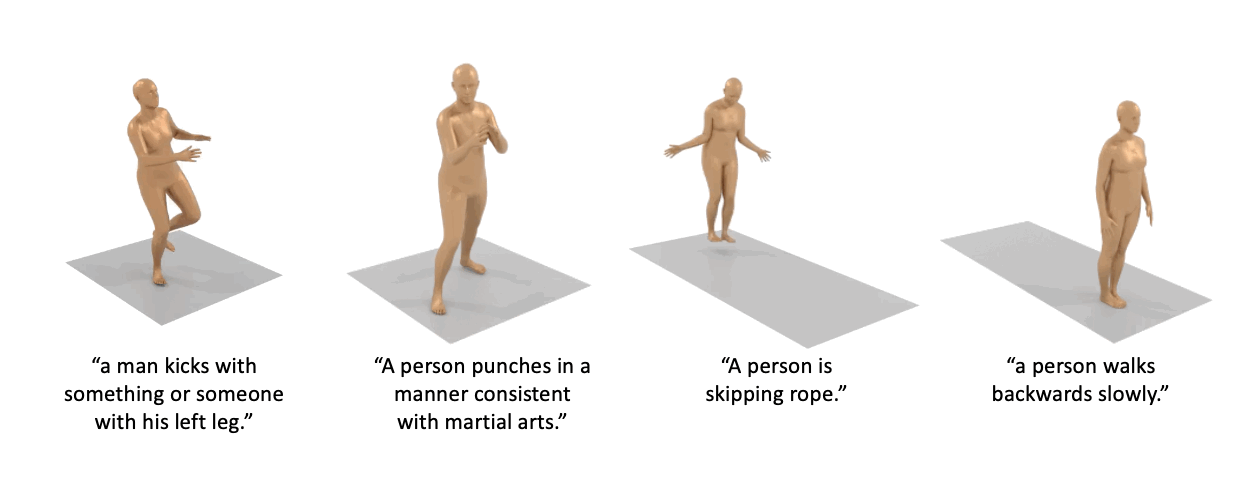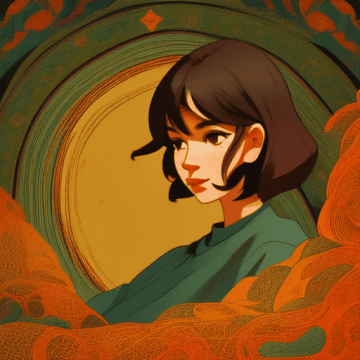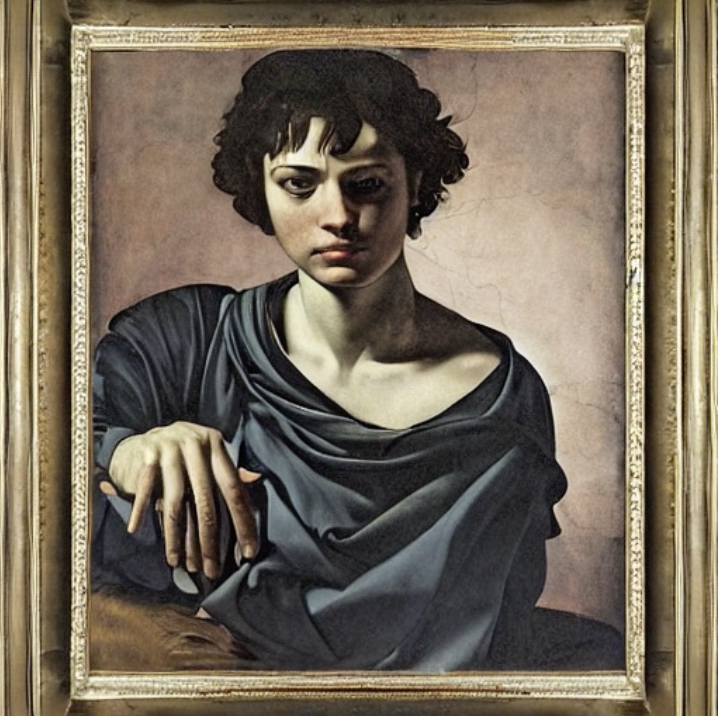motion_diffusion_model
Maintainer: daanelson

14

| Property | Value |
|---|---|
| Model Link | View on Replicate |
| API Spec | View on Replicate |
| Github Link | View on Github |
| Paper Link | View on Arxiv |
Create account to get full access
Model overview
motion_diffusion_model is a diffusion model developed by Replicate creator daanelson for generating human motion video from text prompts. It is an implementation of the paper "Human Motion Diffusion Model" and is designed to produce realistic human motion animations based on natural language descriptions. The model can be used to create animations of people performing various actions and activities, such as walking, picking up objects, or interacting with the environment.
Similar models include stable-diffusion, a latent text-to-image diffusion model that can generate photorealistic images, stable-diffusion-animation, which can animate Stable Diffusion by interpolating between prompts, and animate-diff, which can animate personalized Stable Diffusion models without specific tuning. While these models focus on generating images and videos from text, motion_diffusion_model is specifically designed for generating human motion.
Model inputs and outputs
motion_diffusion_model takes a text prompt as input and generates a corresponding animation of human motion. The text prompt can describe various actions, activities, or scenes involving people, and the model will attempt to create a realistic animation depicting that motion.
Inputs
- Prompt: A natural language description of the desired human motion, such as "the person walked forward and is picking up his toolbox."
Outputs
- Animation: A video sequence of a 3D stick figure animation depicting the human motion described in the input prompt.
- SMPL parameters: The model also outputs the SMPL parameters (joint rotations, root translations, and vertex locations) for each frame of the animation, which can be used to render the motion as a 3D mesh.
Capabilities
motion_diffusion_model is capable of generating a wide variety of human motions based on text descriptions, including walking, running, picking up objects, and interacting with the environment. The model produces realistic-looking animations that capture the nuances of human movement, such as the timing and coordination of different body parts.
One key capability of the model is its ability to generate motion that is semantically consistent with the input prompt. For example, if the prompt describes a person picking up a toolbox, the generated animation will show the person bending down, grasping the toolbox, and lifting it up in a natural and believable way.
What can I use it for?
motion_diffusion_model can be used for a variety of applications that require generating realistic human motion, such as:
- Animation and visual effects: The model can be used to create animations for films, TV shows, or video games, where realistic human motion is important for creating immersive and believable scenes.
- Virtual reality and augmented reality: The model's ability to generate 3D human motion can be used to create interactive experiences in VR and AR applications, where users can interact with virtual characters and avatars.
- Robotics and human-machine interaction: The model's understanding of human motion can be used to improve the way robots and other autonomous systems interact with and understand human behavior.
Things to try
One interesting thing to try with motion_diffusion_model is to experiment with different types of prompts and see how the model responds. For example, you could try generating motion for more abstract or imaginative prompts, such as "a person dancing with a robot" or "a person performing acrobatic stunts in the air." This can help you understand the model's capabilities and limitations in terms of the types of motion it can generate.
Another interesting thing to try is to use the model's SMPL parameters to render the generated motion as a 3D mesh, rather than just a stick figure animation. This can allow you to create more visually compelling and realistic-looking animations that can be integrated into other applications or used for more advanced rendering and animation tasks.
This summary was produced with help from an AI and may contain inaccuracies - check out the links to read the original source documents!
Related Models

stable-diffusion

108.2K
Stable Diffusion is a latent text-to-image diffusion model capable of generating photo-realistic images given any text input. Developed by Stability AI, it is an impressive AI model that can create stunning visuals from simple text prompts. The model has several versions, with each newer version being trained for longer and producing higher-quality images than the previous ones. The main advantage of Stable Diffusion is its ability to generate highly detailed and realistic images from a wide range of textual descriptions. This makes it a powerful tool for creative applications, allowing users to visualize their ideas and concepts in a photorealistic way. The model has been trained on a large and diverse dataset, enabling it to handle a broad spectrum of subjects and styles. Model inputs and outputs Inputs Prompt**: The text prompt that describes the desired image. This can be a simple description or a more detailed, creative prompt. Seed**: An optional random seed value to control the randomness of the image generation process. Width and Height**: The desired dimensions of the generated image, which must be multiples of 64. Scheduler**: The algorithm used to generate the image, with options like DPMSolverMultistep. Num Outputs**: The number of images to generate (up to 4). Guidance Scale**: The scale for classifier-free guidance, which controls the trade-off between image quality and faithfulness to the input prompt. Negative Prompt**: Text that specifies things the model should avoid including in the generated image. Num Inference Steps**: The number of denoising steps to perform during the image generation process. Outputs Array of image URLs**: The generated images are returned as an array of URLs pointing to the created images. Capabilities Stable Diffusion is capable of generating a wide variety of photorealistic images from text prompts. It can create images of people, animals, landscapes, architecture, and more, with a high level of detail and accuracy. The model is particularly skilled at rendering complex scenes and capturing the essence of the input prompt. One of the key strengths of Stable Diffusion is its ability to handle diverse prompts, from simple descriptions to more creative and imaginative ideas. The model can generate images of fantastical creatures, surreal landscapes, and even abstract concepts with impressive results. What can I use it for? Stable Diffusion can be used for a variety of creative applications, such as: Visualizing ideas and concepts for art, design, or storytelling Generating images for use in marketing, advertising, or social media Aiding in the development of games, movies, or other visual media Exploring and experimenting with new ideas and artistic styles The model's versatility and high-quality output make it a valuable tool for anyone looking to bring their ideas to life through visual art. By combining the power of AI with human creativity, Stable Diffusion opens up new possibilities for visual expression and innovation. Things to try One interesting aspect of Stable Diffusion is its ability to generate images with a high level of detail and realism. Users can experiment with prompts that combine specific elements, such as "a steam-powered robot exploring a lush, alien jungle," to see how the model handles complex and imaginative scenes. Additionally, the model's support for different image sizes and resolutions allows users to explore the limits of its capabilities. By generating images at various scales, users can see how the model handles the level of detail and complexity required for different use cases, such as high-resolution artwork or smaller social media graphics. Overall, Stable Diffusion is a powerful and versatile AI model that offers endless possibilities for creative expression and exploration. By experimenting with different prompts, settings, and output formats, users can unlock the full potential of this cutting-edge text-to-image technology.
Updated Invalid Date

animate-diff

41
animate-diff is a plug-and-play module developed by Yuwei Guo, Ceyuan Yang, and others that can turn most community text-to-image diffusion models into animation generators, without the need for additional training. It was presented as a spotlight paper at ICLR 2024. The model builds on previous work like Tune-a-Video and provides several versions that are compatible with Stable Diffusion V1.5 and Stable Diffusion XL. It can be used to animate personalized text-to-image models from the community, such as RealisticVision V5.1 and ToonYou Beta6. Model inputs and outputs animate-diff takes in a text prompt, a base text-to-image model, and various optional parameters to control the animation, such as the number of frames, resolution, camera motions, etc. It outputs an animated video that brings the prompt to life. Inputs Prompt**: The text description of the desired scene or object to animate Base model**: A pre-trained text-to-image diffusion model, such as Stable Diffusion V1.5 or Stable Diffusion XL, potentially with a personalized LoRA model Animation parameters**: Number of frames Resolution Guidance scale Camera movements (pan, zoom, tilt, roll) Outputs Animated video in MP4 or GIF format, with the desired scene or object moving and evolving over time Capabilities animate-diff can take any text-to-image model and turn it into an animation generator, without the need for additional training. This allows users to animate their own personalized models, like those trained with DreamBooth, and explore a wide range of creative possibilities. The model supports various camera movements, such as panning, zooming, tilting, and rolling, which can be controlled through MotionLoRA modules. This gives users fine-grained control over the animation and allows for more dynamic and engaging outputs. What can I use it for? animate-diff can be used for a variety of creative applications, such as: Animating personalized text-to-image models to bring your ideas to life Experimenting with different camera movements and visual styles Generating animated content for social media, videos, or illustrations Exploring the combination of text-to-image and text-to-video capabilities The model's flexibility and ease of use make it a powerful tool for artists, designers, and content creators who want to add dynamic animation to their work. Things to try One interesting aspect of animate-diff is its ability to animate personalized text-to-image models without additional training. Try experimenting with your own DreamBooth models or models from the community, and see how the animation process can enhance and transform your creations. Additionally, explore the different camera movement controls, such as panning, zooming, and rolling, to create more dynamic and cinematic animations. Combine these camera motions with different text prompts and base models to discover unique visual styles and storytelling possibilities.
Updated Invalid Date

stable-diffusion-animation

116
stable-diffusion-animation is a Cog model that extends the capabilities of the Stable Diffusion text-to-image model by allowing users to animate images by interpolating between two prompts. This builds on similar models like tile-morph which create tileable animations, and stable-diffusion-videos-mo-di which generate videos by interpolating the Stable Diffusion latent space. Model inputs and outputs The stable-diffusion-animation model takes in a starting prompt, an ending prompt, and various parameters to control the animation, including the number of frames, the interpolation strength, and the frame rate. It outputs an animated GIF that transitions between the two prompts. Inputs prompt_start**: The prompt to start the animation with prompt_end**: The prompt to end the animation with num_animation_frames**: The number of frames to include in the animation num_interpolation_steps**: The number of steps to interpolate between animation frames prompt_strength**: The strength to apply the prompts during generation guidance_scale**: The scale for classifier-free guidance gif_frames_per_second**: The frames per second in the output GIF film_interpolation**: Whether to use FILM for between-frame interpolation intermediate_output**: Whether to display intermediate outputs during generation gif_ping_pong**: Whether to reverse the animation and go back to the beginning before looping Outputs An animated GIF that transitions between the provided start and end prompts Capabilities stable-diffusion-animation allows you to create dynamic, animated images by interpolating between two text prompts. This can be used to create surreal, dreamlike animations or to smoothly transition between two related concepts. Unlike other models that generate discrete frames, this model blends the latent representations to produce a cohesive, fluid animation. What can I use it for? You can use stable-diffusion-animation to create eye-catching animated content for social media, websites, or presentations. The ability to control the prompts, frame rate, and other parameters gives you a lot of creative flexibility to bring your ideas to life. For example, you could animate a character transforming from one form to another, or create a dreamlike sequence that seamlessly transitions between different surreal landscapes. Things to try Experiment with using contrasting or unexpected prompts to see how the model blends them together. You can also try adjusting the prompt strength and the number of interpolation steps to find the right balance between following the prompts and producing a smooth animation. Additionally, the ability to generate intermediate outputs can be useful for previewing the animation and fine-tuning the parameters.
Updated Invalid Date

stable-diffusion-videos-mo-di

2
The stable-diffusion-videos-mo-di model, developed by wcarle, allows you to generate videos by interpolating the latent space of Stable Diffusion. This model builds upon existing work like Stable Video Diffusion and Lavie, which explore generating videos from text or images using diffusion models. The stable-diffusion-videos-mo-di model specifically uses the Mo-Di Diffusion Model to create smooth video transitions between different text prompts. Model inputs and outputs The stable-diffusion-videos-mo-di model takes in a set of text prompts and associated seeds, and generates a video by interpolating the latent space between the prompts. The user can specify the number of interpolation steps, as well as the guidance scale and number of inference steps to control the video generation process. Inputs Prompts**: The text prompts to use as the starting and ending points for the video generation. Separate multiple prompts with '|' to create a transition between them. Seeds**: The random seeds to use for each prompt, separated by '|'. Leave blank to randomize the seeds. Num Steps**: The number of interpolation steps to use between the prompts. More steps will result in smoother transitions but longer generation times. Guidance Scale**: A value between 1 and 20 that controls how closely the generated images adhere to the input prompts. Num Inference Steps**: The number of denoising steps to use during image generation, with a higher number leading to higher quality but slower generation. Outputs Video**: The generated video, which transitions between the input prompts using the Mo-Di Diffusion Model. Capabilities The stable-diffusion-videos-mo-di model can create visually striking videos by smoothly interpolating between different text prompts. This allows for the generation of videos that morph or transform organically, such as a video that starts with "blueberry spaghetti" and ends with "strawberry spaghetti". The model can also be used to generate videos for a wide range of creative applications, from abstract art to product demonstrations. What can I use it for? The stable-diffusion-videos-mo-di model is a powerful tool for artists, designers, and content creators looking to generate unique and compelling video content. You could use it to create dynamic video backgrounds, explainer videos, or even experimental art pieces. The model is available to use in a Colab notebook or through the Replicate platform, making it accessible to a wide range of users. Things to try One interesting feature of the stable-diffusion-videos-mo-di model is its ability to incorporate audio into the video generation process. By providing an audio file, the model can use the audio's beat and rhythm to inform the rate of interpolation, allowing the videos to move in sync with the music. This opens up new creative possibilities, such as generating music videos or visualizations that are tightly coupled with a soundtrack.
Updated Invalid Date